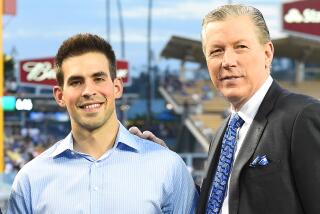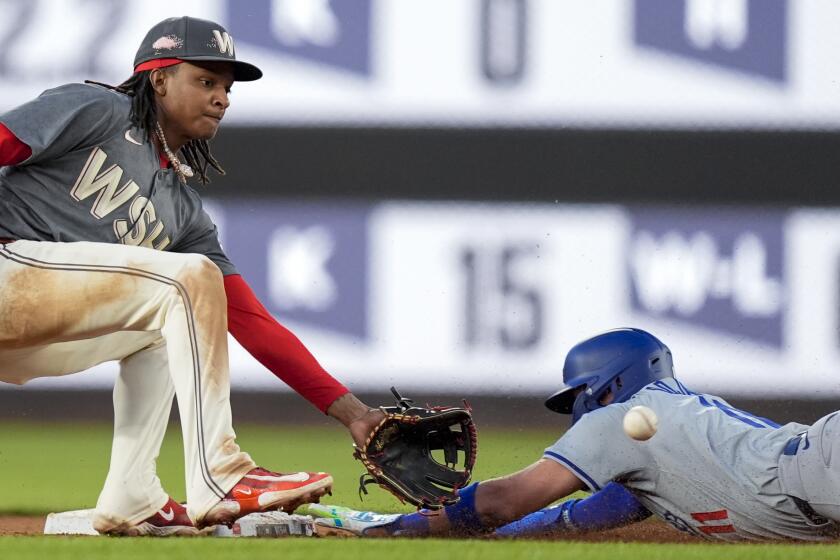Dodgers Dugout: Joe Davis answers your questions
Hi, and welcome to another edition of Dodgers Dugout. My name is Houston Mitchell. First a sewage pipe leaks, now the power goes out — someone needs to complain to the landlord.
Ask Joe Davis
While we are waiting to see if the Dodgers make any more moves before the non-waiver trade deadline, Dodgers announcer Joe Davis has been kind enough to answer some reader questions again this season. We got hundreds of questions, so if your question wasn’t answered, I apologize. I’m sure we’ll do this again sometime, so keep trying. And if a question was asked more than once, I went with the name of the first person to ask it.
Steve Rosenberg asks: In watching the games each night, one can clearly see that each umpire has a different strike zone and some strike zones are more liberal than others. In this age of data analytics, do the teams have reports on each umpire so they kind of know what strike zone to expect? Or are the umpires so inconsistent from game to game that analytics doesn’t help much?
Joe: They do have scouting reports on each umpire. Pretty detailed, in fact, with breakdowns based on pitch type, handedness of hitter/pitcher, which parts of the strike zone they’re generous, which parts they won’t budge on. The umpire scouting reports are actually pretty similar looking to some of the hot/cold zone profiles you’d see for a player.
Norm McQuillin asks: Matt Kemp seems to always have a smudge of dirt on his back shoulder in the same place all the time. What’s the story about that?
Joe: Same thing with Justin Turner, right? It’s from the pine tar on his bat handle, and comes as part of his on-deck routine.
Alan Valensky asks: It’s obvious when listening to you tell interesting stories about the players that Vin Scully rubbed off on you. Did Vinnie spend time mentoring you during his last season or did you just learn by watching and studying?
Joe: It always means a lot to me when people recognize some Vin elements in what I’m doing, so thank you. I never want to try to be Vin — that’s impossible — but it’d also be unwise not to try to incorporate some of the things that made him the best ever.
The storytelling is one of those things. l’ll never be half the storyteller Vin was, but I do my very best to keep that story element alive in the broadcasts because I know it’s one of the primary things people loved most about Vin. And honestly, when I go back and listen and critique myself, I find my ears perking up when I hear myself telling a story. It really is way more interesting than hearing what the guy’s batting average is.
So, I try to honor that tradition and that responsibility that comes with this job.
Eli Van Sickel: You and Orel Hershiser seem to have a lot of fun in the booth. Was there any sort of practice or warm-up period that you needed to get comfortable calling games with the Bulldog?
Joe: Orel has quickly become one of my closest friends. He’s the biggest reason for my enjoyment of the job these first few years.
We hit it off pretty quickly. We’re wired similarly — both pretty anal, both care deeply about doing the job well. And while there’s the obvious generational difference, he’s more of the jokester and I’m more serious, so we kind of mesh perfectly in the middle.
Closest thing to practice would be spring training. Bigger thing for real chemistry, I think, is spending time together away from the booth. And we spend a ton of time together.
Ed Costello: How did you get the job with the Dodgers?
Joe: I still ask myself that occasionally. The very, very short version — bosses heard me doing a national MLB game for Fox.
Reed Rosien: How early do you get to the ballpark for a game to cover/broadcast?
Joe: Three to four hours before, but I spend much of my time at home/hotel during the day preparing for that night.
Norm Levine: It seems that Cody Bellinger is a most sociable guy. When an opposing player gets to first base the camera often focuses on him talking to the base runner. My wife and I call him Chit-Chat. What in the world are they talking about?
Joe: That’s a funny nickname. I’m sure the topics vary, but knowing Cody, it probably begins with “’Sup?” and goes from there. Super likable young guy.
Michael Plunkett: What was the hardest thing you found/learned in following Vin and what was the easiest thing you found/learned in following Vin?
Joe: Hardest thing sounds simple, but it’s not: just being myself. That was Vin’s advice to me, the same advice passed along to him by Red Barber in 1950. The reason it’s not as easy as it sounds is I think it’s human nature to try and copy what’s been so successful for the person that held the chair before you for 67 Hall of Fame years.
As I mentioned in a previous answer, though — the key for me has been learning from what made Vin so special and applying it to my own way of calling a game, as opposed to just trying to be Vin.
There will never be another like him. But that doesn’t mean I can’t try to learn from what made him the greatest.
Phyllis Wade: Hi Joe, I get nervous every time I hear that sooner or later the National League will have the designated hitter. I don’t know what that game is they play over there in the American League — but it’s not baseball. Do you think the DH is in our future?
Joe: I’m worried that you’re right — the DH will be in both leagues at some point. But I’m with ya, Phyllis — there’s such an added layer of strategy in the NL game that you’d lose. I love the NL game, and I like the fact that the two leagues are distinctly different in that way.
Steve Hockett: Hi Joe. You are doing a great job! Do you really get along with Orel that well? Where are you on weekends?
Joe: Hi Steve. Because baseball is such a long season, I’ve always thought that if you’re faking it, it’ll get exposed as such. Whether it’s your voice or your knowledge or your chemistry — if it’s not genuine, that’s going to come through over the course of a baseball season.
All that is to say that what you hear from Orel and me — that’s real. That’s an extension of what you’d hear if you were hanging in the booth before the microphones turn on or sitting with us on the plane or joining us for dinner. The chemistry you’re referencing is, at its simplest, just a really special friendship.
As for your second question: I call games nationally for Fox. MLB mostly between Memorial Day and the All-Star Game (and Division Series in October), and college football once that season begins. I always try to miss as few Dodger games as possible when I do leave. For example, I have Yankees/Red Sox in Boston this Saturday, so I’m going to do Dodgers/Astros Friday night in L.A., redeye to Boston, land at 9 a.m., game at 4 p.m., 6 a.m. flight back to L.A. Sunday, in time for Dodgers/Astros at 1 p.m. that afternoon.
David Lehman: Where did you go to college? Did you cover sports on radio or for the college newspaper? You’re terrific and you make a great team with Orel Hershiser.
Joe: Thanks David. I went to Beloit College in Wisconsin. About 1,500 students. Played football there. Recruiting pitch from the football coach was that I could announce the basketball games right away. He knew the way to my heart.
Doug Brown: How much guidance and/or instruction are announcers given by the networks and the team? Are you allowed to call the games as you wish or are you advised by a director or someone to focus more on particular players, describe the scenery more, keep your opinions to yourself, etc.? Since you are calling a live ball game, you can’t be scripted, but I am curious if you are given stories and anecdotes beforehand to read.
Joe: There are certain things like promoting upcoming homestands, etc, that the team has us talk about. But besides that, they don’t tell us what to talk about. Which is great.
As far as materials we’re given beforehand — there’s no shortage of information available these days, but it’s up to the individual broadcaster to find it and study it and be able to present it on the air. Those are mostly stats based. The stories take extra digging.
Justin Martinez: Who is your favorite current player in the MLB is and who is your favorite Dodger to watch play?
Joe: Easy answer is Clayton Kershaw. Historical greatness. As he’s dealt with the injuries he’s not been as dominant, but that doesn’t change how lucky I feel to watch him add to his story every fifth day. Walker Buehler has become a guy that I look forward to watching with the same kind of excitement.
I’m loving watching Manny Machado so far. I knew he was great from looking at his numbers in Baltimore, but to see him every day is to really appreciate just how special he is.
Across baseball, I’m a fan of the guys that play with a clear joy for the game. Jose Altuve. Javier Baez. Francisco Lindor. Those are just a few that spring to mind without giving it a ton of thought.
More KTLA games
For those of you who live in the L.A. area and are unable to see Dodgers games on TV, the team has announced that four games in August and one in September will be televised on KTLA Channel 5. Those games are:
Saturday, Aug. 4 vs. Houston, 6 p.m.
Wednesday, Aug. 15 vs. San Francisco, 7 p.m.
Monday, Aug. 20 vs. St. Louis, 7 p.m.
Friday, Aug. 31 vs. Arizona, 7 p.m.
Tuesday, Sept. 4 vs. New York Mets, 7 p.m.
Meanwhile, there is no agreement between DirecTV and Spectrum SportsNet coming in the near future.
These names seem familiar
What recently departed Dodgers are doing around the league (through Saturday):
Charlie Culberson, Braves, .280/.329/.456, 114 OPS+.
Brandon McCarthy, Braves, 6-3, 4.92 ERA (currently on the 10-day DL with right knee tendinitis).
Yu Darvish, Cubs, 1-3, 4.95 ERA (currently on 10-day DL with an elbow injury)
Curtis Granderson, Blue Jays, .234/.336/.421, 107 OPS+
Brandon Morrow, Cubs, 0-0, 22 saves, 1.47 ERA (currently on 10-day DL with right biceps tendinitis)
Tony Watson, Giants, 3-4, 2.17 ERA
Chris Hatcher, A’s, 3-2, 4.24 ERA
Luis Avilan, White Sox, 2-0, 3.94 ERA
Trayce Thompson, White Sox, .117/.162/.211 (removed from 40-man roster and sent to minors). Hitting .177/.275/.291 for triple-A Charlotte.
Wilmer Font, Rays, 2-0, 4.28 ERA (on 60-day DL with a lat strain)
Sergio Romo, Rays, 1-2, 3.69 ERA, 12 saves.
Up next
Tuesday, 7 p.m.: Milwaukee (Wade Miley, 1-1, 2.01 ERA) at Dodgers (Walker Buehler, 4-3, 3.92 ERA)
Wednesday, 7 p.m.: Milwaukee (Chase Anderson, 7-7, 3.69 ERA) at Dodgers (Rich Hill, 4-4, 3.82 ERA)
Thursday, 6 p.m.: Milwaukee (Jhoulys Chacin, 10-3, 3.45 ERA) at Dodgers (Clayton Kershaw, 4-5, 2.52 ERA)
And finally
Julio Urias could give Dodger bullpen a boost. Read all about it here. Longtime Dodgers clubhouse manager Nobe Kawano dies at 95. Read about it here.
Have a comment or something you’d like to see in a future Dodgers newsletter? Email me and follow me on Twitter: @latimeshouston.
More to Read
Are you a true-blue fan?
Get our Dodgers Dugout newsletter for insights, news and much more.
You may occasionally receive promotional content from the Los Angeles Times.







